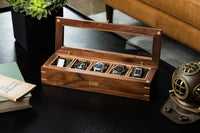Now that we’ve fallen back into Standard time and the days grow shorter, it's time to start getting ready for your various holiday parties.
While this is a fine time to break out the good vintages and pull the old malts from the back of the cabinet, if you're like us, you'll find yourself entertaining several times. To that end, nothing celebrates the holiday season like tradition and plenty, and a well-constructed punch is the perfect example of both — you can dazzle your guests with a bit of history, or simply serve up a flowing bowl for a couple dozen of your closest friends.

Punch is the prototypical cocktail, the ancestor of all mixed drinks. Like most tipples, it was born of necessity — in this case, a way to keep sailors healthy and happy a long way from home. The Royal Navy, engine of the Empire upon which the sun didn’t set for centuries, provided a daily “tot” of rum to its sailors after it became clear that their prior ration — four liters of beer per sailor — was difficult to maintain on long voyages.
In East Asia, the daily grog was often combined with citrus juice to prevent scurvy and sweetened with local sugar and spices to make it go down easier. This then was the basis for punch, which found its way to England via the Admiralty, and onward to country houses and banquets.

Punch: The Delight (and Danger) of the Flowing Bowl - (Image by AbeBooks)
The history is fascinating stuff, and we recommend Dave Wondrich's Punch: The Delights (and Dangers) of the Flowing Bowl for a comprehensive survey — but for our purposes, a large quantity of spirits, sweetened with sugar, soured with citrus, and flavored with tea and spices will suffice. We include some notes on technique that may seem a bit fussy, but details make the difference between an elegant tipple and a trashcan full of jungle juice.
Our ingredients:
Spirit is the first big question — where to begin? The primary vectors in traditional punches are cane spirits: rum, rhum, ron, arrack. Any place that grows sugarcane also ferments and distills it, making for a wild number of choices. For our purposes, look for something round and gently aged from former British colonies, and consider “splitting the base” — i.e. using two base spirits in equal measure — with an aromatic brown spirit such as Cognac. Whisky is an acceptable choice if that's your or your guests' preference, but the holidays are all about playing the hits. More in a moment…
Sugar is a consideration as well — for maximum flavor and body, you'll want a less refined sugar, something with more aromatic byproducts. At your local grocer, a demerara or turbinado sugar is perfect; piloncillo, panela, or jaggery are all a nice upgrade. The sugar is going to both draw some of the oils out of the citrus as well as balance the tannins in your tea, so boldness and richness are both important.
Citrus is the next step — the standard grocery store lemon is a heavily hybridized and specialized breed, and isn’t particularly notable for flavor or aroma so much as its hardiness in transport. Since the holidays are when citrus is in season in the northern hemisphere, this is a great time to use Meyer lemons, or especially ripe key limes. The bartender's adage that “the lighter the spirit, the darker the citrus” is one to keep handy.
Tea will be the weak part of our mixture, but also bears some thought — investing in some great black tea is a great way to ensure you're working with the brightest palette. Earl Grey tea is a fine place to start, with its added oil of bergamot (an aromatic citrus cultivar), but if you're already a tea fiend, go ahead and play between your preferred Assam or Darjeeling depending on how malty or floral you want the end product to be. We recommend working with a conscientious supplier to ensure both the quality of the product and the conditions under which it is harvested and processed; In Pursuit of Tea has long been a preferred broker and vendor.
Spice is the final consideration in crafting our holiday punch. The nutmeg we’re going to use must be freshly ground; do it at any volume and you'll understand why the stuff was more precious than gold — and vaunted as an aphrodisiac. (An aside: If you choose to spice your black tea, get a nice, chai masala from a vendor like Spicewalla or Diaspora Spice Co.)
You'll need:
32 ounces aged Rum (Age is less important than finding a flavor profile you like. Consult your local cocktail bar to try some out.)
20 ounces Cognac (We suggest a VSOP grade or finer)
40 ounces brewed black tea
6 ounces Meyer lemon juice
1.5 cups by volume of unrefined sugar such as turbinado or panela
2 oranges, sliced (for garnish)
Directions:
Start by peeling the lemons with a vegetable peeler into strips, then combine them in a bowl with the sugar, muddling them together to extract oils from the peels — let this rest for 30 minutes.
Once this has formed a syrup, add the spirits and the (still hot) brewed tea. Skim off the citrus peels and add sliced oranges and some grated nutmeg.
Serve by ladling, still hot, into individual mugs or cups, and grate nutmeg over each.
(Serves 30)













